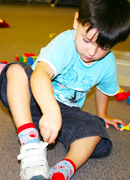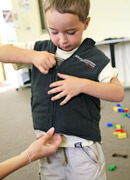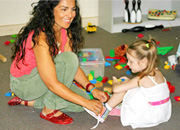Behaviour
Caring for babies
Bottle feeding
Changing a nappy
Cleaning and sterilising bottles
Daily cleaning tasks
Helping new children settle in
Preparing for a nappy change
Sleep patterns – babies
Sleep routines – babies
Toilet training
Caring for children
Allowing time for practice
Dressing/undressing
Mealtimes
Nappy change
Packing away/caring for the environment
Sleep/rest time
Toileting
Common self-help milestones
Tips for sleep and rest time
Self image
Communication
Body language
Limits and guidelines
Ways children communicate
Greeting children and families
Modelling appropriate communication
Questioning
Verbal and non–verbal communication
Acknowledging children's feelings
Listening attentively
Communicating with Aboriginal and Torres Strait Islander parents/carers
Development
Allowing time for practice
Dressing/undressing
Mealtimes
Nappy change
Packing away/caring for the environment
Sleep/rest time
Toileting
Common self-help milestones
Creative development
Language development
Modelling positive relationships
Physical development
Sharing and taking turns
Sleep patterns – babies
Sleep routines – babies
Encourage independent problem solving
Fundamental movement skills
Health, hygiene and safety
Coping with stress
Correct manual handling principles
Daily cleaning tasks
Hand washing
Hand washing poster
Manual handling overview
Toilet training
Safety checklist
Learning experiences and play
Environmentally friendly learning experiences
Learning experiences for different development areas
Creative resource materials
Arranging the environment to facilitate learning and pleasure
Indoors and outdoor areas
Creating a positive physical environment
Legal and ethical issues
Child abuse case studies
How do I recognise when a child or young person is at risk?
Tips on dealing with disclosures
Observation methods
Arranging Experiences (PDF 351Kb)
Recording observations
Rules for making observations
What you can learn from observations
Programming
Children’s interests, strengths, needs and skills
Extending the children’s interest in dinosaurs
Objective observation
Planning an OSHC environment
Behavior management plan
Planning enjoyable experiences
Planning experiences for 0 - 2 years age group
Planning experiences for 2 - 3 years age group
Planning experiences for 3 - 5 years age group
Building self-help skills: dressing/undressing
For young children this skill can often be the most difficult to master.
Dressing and undressing can offer children some challenging moments. You can use these moments to:
- promote cooperation
- encourage decision making
- develop and practise self-help skills.
For instance, when taking off the sock or bootie of a very young infant, you can pull the sock half off and encourage the child to pull it right off. Little coordination is needed when the task is set up like this. Children get a lot of pleasure and satisfaction from helping out. The idea is to simplify the task so the child gets to practise and remember the process. At first it takes longer to work cooperatively together, but when children are encouraged to help dress/undress themselves they become more proficient. They reach the point where they need very little help, except with such things as buttons, zips and laces.
Work through the information below, for ideas on how you can build self-help skills and promote cooperation in the dressing and undressing processes.

Encourage parents to provide clothing that is easy to manage - tracksuit pants, velcro runners etc.
Step in to prevent frustration when children attempt a task that may be too difficult.

Talk with them about what you are doing.

Give lots of positive encouragement for all attempts.

Keep instructions simple, take it one step at a time and provide opportunities to practise.